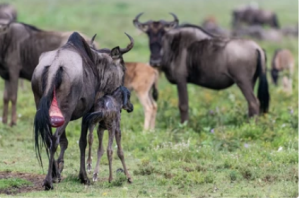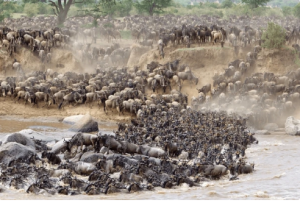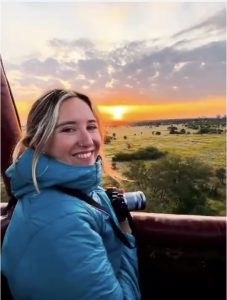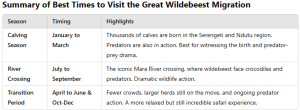 Best Times to Witness the Great Wildebeest Migration in Tanzania
Best Times to Witness the Great Wildebeest Migration in Tanzania
The Great Wildebeest Migration is one of the most incredible wildlife spectacles on the planet, and Tanzania offers the perfect vantage point to witness this awe-inspiring journey. Over 1.5 million wildebeest, along with zebras and gazelles, make an annual trek through the Serengeti and Masai Mara ecosystems, driven by the quest for food and water. The timing of your safari can significantly influence what you see during this natural wonder. Here’s a guide to the best times to witness the Great Wildebeest Migration in Tanzania.
1. The Calving Season: January to March
Why Visit During This Time?

- Newborn Calves: Between January and March, the wildebeest give birth to their calves in the southern Serengeti plains and the Ndutu area. This is one of the most thrilling and emotional periods of the migration. With over 500,000 calves born in a short period, you’ll witness the sheer spectacle of life as newborns take their first steps on the African plains.
- Predator Action: The calving season also draws predators, such as lions, cheetahs, and hyenas, creating dramatic hunts as they target the vulnerable newborns. This provides incredible opportunities for photographers and wildlife enthusiasts to capture the harsh realities of nature.
Best Areas to Visit:
- Serengeti (Southern Plains) and Ndutu Area: The southern Serengeti, including Ndutu, is the epicenter of the calving season.
- Ngorongoro Crater: Just a short drive from the Serengeti, the crater is home to resident wildlife like lions, leopards, and rhinos.
2. The River Crossing: July to September
Why Visit During This Time?

- The Mara River Crossings: The most iconic and dramatic phase of the Great Migration occurs between July and September when the wildebeest faces the dangerous crossing of the Mara River. The sight of thousands of wildebeest plunging into the river, braving crocodiles and predators, is one of the most iconic wildlife scenes in the world.
- Predator Action: As the herds gather along the riverbanks, lions, crocodiles, and other predators are in wait, creating high-stakes action. The river crossing is often considered the peak of the migration, making this a popular time for safari-goers.
Best Areas to Visit:
Serengeti (Western Corridor): This is the key area for witnessing the river crossings, as the wildebeest make their way from the southern Serengeti to the northern regions.
Masai Mara (Kenya): While this part of the migration is mostly in Tanzania, the Mara River runs across the border into Kenya, where the wildebeest often end up during the later part of the migration.
3. The Transition Period: April to June & October to December
Why Visit During This Time?
- Fewer Crowds: Traveling outside the peak months of the migration means fewer tourists, allowing you to enjoy a more peaceful safari experience.
- Large Herds: Even during these months, there are still large herds of wildebeest scattered across Tanzania’s vast plains. They are typically moving between the southern and central Serengeti (April to June) or heading back toward the southern Serengeti (October to December).
- Predator Viewing: While the drama of the river crossings is over, predator activity remains strong. Lions, leopards, and cheetahs are still active, offering great opportunities for wildlife viewing.
Best Areas to Visit:
Serengeti Central & Northern
Regions: These areas are less crowded during the transition periods, but you can still see sizable herds of wildebeest moving between grazing areas.
Ngorongoro Crater & Lake Manyara: These regions remain excellent for wildlife viewing year-round, even when the migration is not the main event.
Conclusion
The Great Wildebeest Migration is an unparalleled wildlife event that offers a lifetime of memories. Whether you visit during the calving season, the river crossings, or the quieter months of the migration, there’s no bad time to experience the magic of Tanzania’s wilderness. To ensure the best experience, it’s crucial to plan your visit around the time of year that aligns with the migration’s different phases. Whichever season you choose, a safari to witness this extraordinary natural phenomenon is sure to be an unforgettable adventure. Ready to plan your own migration safari? Let us guide you to the heart of the Great Wildebeest Migration and help you make memories that will last a lifetime!










